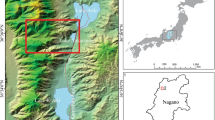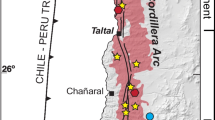Abstract
A subaqueous volcaniclastic mass-flow deposit in the Miocene Josoji Formation, Shimane Peninsula, is 15–16 m thick, and comprises mainly blocks and lapilli of rhyolite and andesite pumices and non- to poorly vesiculated rhyolite. It can be divided into four layers in ascending order. Layer 1 is an inversely to normally graded and poorly sorted lithic breccia 0.3–6 m thick. Layer 2 is an inversely to normally graded tuff breccia to lapilli tuff 6–11 m thick. This layer bifurcates laterally into minor depositional units individually composed of a massive, lithic-rich lower part and a diffusely stratified, pumice-rich upper part with inverse to normal grading of both lithic and pumice clasts. Layer 3 is 2.5–3 m thick, and consists of interbedded fines-depleted pumice-rich and pumice-poor layers a few centimeters thick. Layer 4 is a well-stratified and well-sorted coarse ash bed 1.5–2 m thick. The volcaniclastic deposit shows internal features of high-density turbidites and contains no evidence for emplacement at a high temperature. The mass-flow deposit is extremely coarse-grained, dominated by traction structures, and is interpreted as the product of a deep submarine, explosive eruption of vesicular magma or explosive collapse of lava.
Similar content being viewed by others
Author information
Authors and Affiliations
Rights and permissions
About this article
Cite this article
Kano, K. A Miocene coarse volcaniclastic mass-flow deposit in the Shimane Peninsula, SW Japan: product of a deep submarine eruption?. Bull Volcanol 58, 131–143 (1996). https://doi.org/10.1007/s004450050131
Received:
Accepted:
Published:
Issue Date:
DOI: https://doi.org/10.1007/s004450050131




